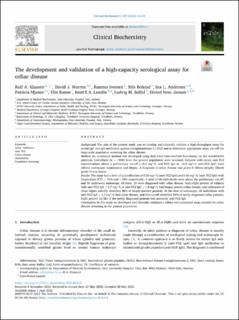| dc.contributor.author | Klaasen, Rolf | |
| dc.contributor.author | Warren, David | |
| dc.contributor.author | Iversen, Rasmus | |
| dc.contributor.author | Bolstad, Nils | |
| dc.contributor.author | Andersen, Ina Lervåg | |
| dc.contributor.author | Mjønes, Patricia | |
| dc.contributor.author | Rønne, Elin | |
| dc.contributor.author | Lundin, Knut | |
| dc.contributor.author | Sollid, Ludvig Magne | |
| dc.contributor.author | Ness-Jensen, Eivind | |
| dc.date.accessioned | 2022-09-16T09:33:28Z | |
| dc.date.available | 2022-09-16T09:33:28Z | |
| dc.date.created | 2022-09-12T10:55:14Z | |
| dc.date.issued | 2022 | |
| dc.identifier.citation | Clinical Biochemistry. 2022, 107 13-18. | en_US |
| dc.identifier.issn | 0009-9120 | |
| dc.identifier.uri | https://hdl.handle.net/11250/3018382 | |
| dc.description.abstract | Background
The aim of the present study was to develop and clinically validate a high-throughput assay for serum IgA and IgG antibodies against transglutaminase-2 (TG2) and to determine appropriate assay cut-offs for large-scale population screening for celiac disease.
Method
An automated method was developed using dual label time-resolved fluorometry on the AutoDELFIA platform. Individuals (n = 1920) from the general population were screened. Subjects with serum anti-TG2 concentrations above a preliminary cut-off (>0.3 mg*/L anti-TG2 IgA or >0.5 mg*/L anti-TG2 IgG) were offered endoscopic examination and biopsy. A diagnosis of celiac disease was given if villous atrophy (Marsh grade 3) was found.
Results
The assay had a limit of quantification of 0.25 mg*/L (anti-TG2 IgA) and 0.60 mg*/L (anti-TG2 IgG) with imprecision (CV) < 16% and <18% respectively. A total of 66 individuals were above the preliminary cut-off, and 56 underwent endoscopy. Of these, 26 were diagnosed with celiac disease. Sixty-eight percent of subjects with anti-TG2 IgA ≥ 0.7 mg*/L or anti-TG2 IgG ≥ 1.0 mg*/L had biopsy-proven celiac disease, and utilization of these higher cut-offs identified 96% of biopsy-positive patients. At the time of endoscopy, all individuals with anti-TG2 IgA > 2.0 mg*/L had celiac disease, and this cut-off identified 88% of newly diagnosed celiac patients. Eight percent (2/26) of the newly diagnosed patients had primarily anti-TG2 IgG.
Conclusions
In this study we developed and clinically validated a robust and automated assay suitable for celiac disease screening in the general population. | en_US |
| dc.language.iso | eng | en_US |
| dc.publisher | Elsevier | en_US |
| dc.rights | Attribution-NonCommercial-NoDerivatives 4.0 Internasjonal | * |
| dc.rights.uri | http://creativecommons.org/licenses/by-nc-nd/4.0/deed.no | * |
| dc.title | The development and validation of a high-capacity serological assay for celiac disease | en_US |
| dc.title.alternative | The development and validation of a high-capacity serological assay for celiac disease | en_US |
| dc.type | Peer reviewed | en_US |
| dc.type | Journal article | en_US |
| dc.description.version | publishedVersion | en_US |
| dc.source.pagenumber | 13-18 | en_US |
| dc.source.volume | 107 | en_US |
| dc.source.journal | Clinical Biochemistry | en_US |
| dc.identifier.doi | 10.1016/j.clinbiochem.2022.05.010 | |
| dc.identifier.cristin | 2050680 | |
| dc.relation.project | Stiftelsen Kristian Gerhard Jebsen: SKGJ-MED-017 | en_US |
| cristin.ispublished | true | |
| cristin.fulltext | original | |
| cristin.qualitycode | 1 | |

